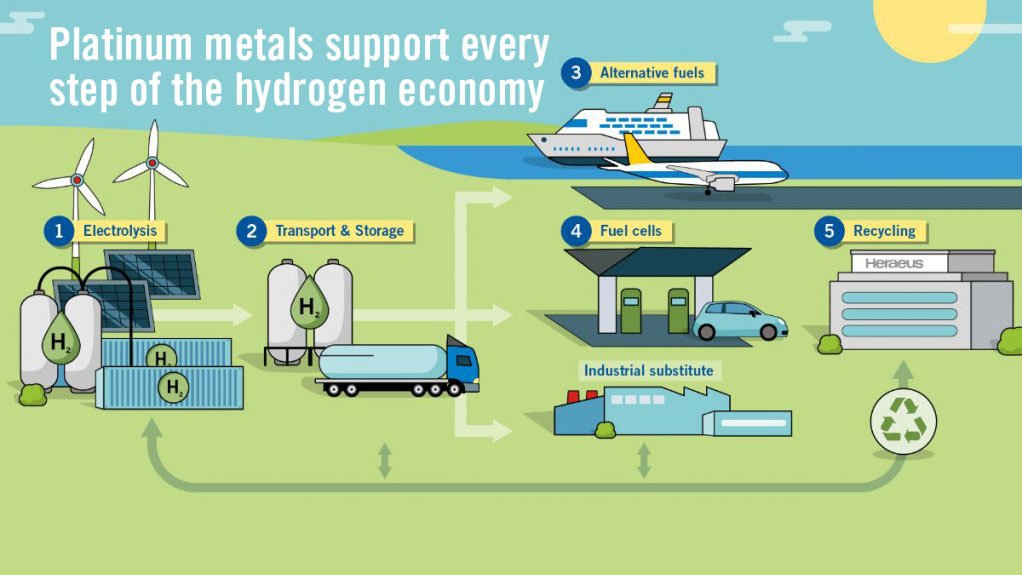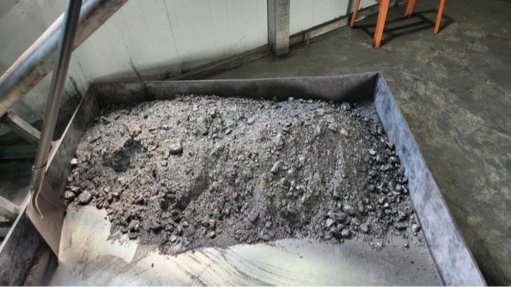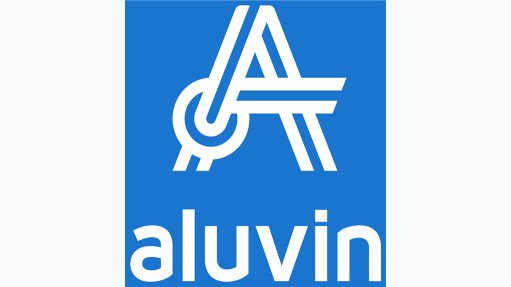Platinum-linked green hydrogen set to be world’s ‘new oil’, Forbes article highlights


Hydrogen economy, platinum group metals go together.
Photo by Inforgraphic: Heraeus Precious Metals
JOHANNESBURG (miningweekly.com) – There's no climate solution without hydrogen. It’s the missing piece of the clean energy puzzle, says a global CEO-led initiative that brings together leading companies with a united vision.
This initiative has ballooned to 150 multinationals companies from its modest 13-leader 2017 launch at the World Economic Forum.
The global Hydrogen Council it has advanced into now represents the entire value chain of hydrogen, which is planet earth’s most abundant element, as well as being renewable and non-polluting.
“We need to embrace hydrogen as a global energy solution now more than ever,” is what is being stated by this council, amid hydrogen development taking place left, right and centre across Asia, Europe, the Americas and to a lesser but moderately advancing extent in Africa.
"The energy transition is happening faster than many people (including me!) dared hope," Microsoft luminary Bill Gates stated in an article this week, after visiting a Texas company in which the platinum group metals-promoting and South Africa-linked venture capital company, AP Ventures, is associated.
Meanwhile, Forbes magazine’s contributor on energy and climate Ken Silverstein commented that it's just a matter of green hydrogen getting its legs for it to become the world's ‘new oil’ to replace the non-sustainable, finite-horizoned energy source that currently drives the global economy.
As a result, countries are forming international hydrogen coalitions to position themselves for the green hydrogen 'new oil' future and many are looking to forward to the potential of hydrogen providing their countries with energy independence and sovereignty.
What must be noted is that the proton exchange membrane (PEM) electrolysers that produce green hydrogen most efficiently benefit from the very special attributes of Southern Africa's platinum group metals, as do the PEM fuel cells that turn that green hydrogen into the cleanest of clean electricity that can not only power buses, bikes, bakkies, cars, cargo carriers, trains and ships better than anything else but can also provide clean, green electricity in stationary off-grid form to, you name it – homes, commercial buildings, factories, farms, and industry as a whole.
Meanwhile, the United Arab Emirates, which is targeting a 25% global market share of low-carbon hydrogen by 2030, is joining forces with Germany, the Forbes magazine article stated, to expand its hydrogen portfolio.
Japan, it added, is converting fossil-fired plants into hydrogen-based plants and South Korea is setting aside tens of billions of dollars to expand its hydrogen infrastructure and build a fuel cell base.
The European Union is fast-tracking 65 hydrogen projects after signing an energy infrastructure list into law, Hydrogen Insight reports.
Australian company Fortescue has opened an electrolyser manufacturing facility in Gladstone, Queensland, that has an automated assembly line, the World Platinum Investment Council reports.
Fortescue has also unveiled a joint venture with Morocco-headquartered plant nutrition and phosphate-based fertiliser supplier OCP Group, which aims to supply green hydrogen, ammonia and fertilisers to Morocco, Europe and international markets.
In the UK, a platinum-using PEM fuel cell for cars, the smallest to date, has been developed by Intelligent Energy.
Hydrogen South Africa at North-West University embarked on building dedicated rapid prototyping, testing and training facilities for water electrolysis that generates green hydrogen. The 15 000 m2 advanced manufacturing facility, constructed and fully commissioned in just over two years, will have capacity to produce over 2 GW of PEM electrolyser stacks a year.
The Japanese government has revealed a multitrillion-yen plan to develop a regional aircraft powered by next generation technology such as hydrogen.
Newsbreaks on the outlook for the hydrogen economy are regular and the momentum towards making green hydrogen competitive and developing human resources to meet the needs of green hydrogen is building strongly.
Twelve scientists from Southern African Development Community (SADC) countries will head to Germany in May, where they will have an opportunity to obtain more in-depth insight into green hydrogen amid the region’s unveiling of important green hydrogen projects, pilot plant initiatives and the awarding of a large number of green hydrogen scholarships.
Separate from the dozen selected scientists, the first cohort of students left for Germany immediately after the Sasscal-organised two-day Green Hydrogen Symposium in Windhoek last month with more to follow.
"History is in the making and I’m very glad we’re part of it," said Sasscal executive director Dr Jane Olwoch in a Zoom interview with Engineering News & Mining Weekly.
Sasscal is SADC's science service centre for climate change and adaptive land management and the symposium was for participating countries, such as Angola, Botswana, Democratic Republic of Congo, Eswatini, Malawi, Mauritius, Mozambique, Namibia, South Africa, Tanzania, Zambia and Zimbabwe, accentuated green hydrogen practice, fast-advancing pilot plants and far-reaching skills development to support Southern Africa’s green hydrogen thrust.
On the continent of Africa as a whole, it is reported that only about 5% of project investment volume is at the front-end engineering design (FEED) and further (FEED+) stages, compared with 20% globally and an estimated 1% is past the final investment decision (FID), compared with the world’s 7% FID level.
There is, therefore, an opportunity for stakeholders to realise Africa’s hydrogen potential for its citizens and for the world, many are emphasising.
Article Enquiry
Email Article
Save Article
Feedback
To advertise email advertising@creamermedia.co.za or click here
Press Office
Announcements
What's On
Subscribe to improve your user experience...
Option 1 (equivalent of R125 a month):
Receive a weekly copy of Creamer Media's Engineering News & Mining Weekly magazine
(print copy for those in South Africa and e-magazine for those outside of South Africa)
Receive daily email newsletters
Access to full search results
Access archive of magazine back copies
Access to Projects in Progress
Access to ONE Research Report of your choice in PDF format
Option 2 (equivalent of R375 a month):
All benefits from Option 1
PLUS
Access to Creamer Media's Research Channel Africa for ALL Research Reports, in PDF format, on various industrial and mining sectors
including Electricity; Water; Energy Transition; Hydrogen; Roads, Rail and Ports; Coal; Gold; Platinum; Battery Metals; etc.
Already a subscriber?
Forgotten your password?
Receive weekly copy of Creamer Media's Engineering News & Mining Weekly magazine (print copy for those in South Africa and e-magazine for those outside of South Africa)
➕
Recieve daily email newsletters
➕
Access to full search results
➕
Access archive of magazine back copies
➕
Access to Projects in Progress
➕
Access to ONE Research Report of your choice in PDF format
RESEARCH CHANNEL AFRICA
R4500 (equivalent of R375 a month)
SUBSCRIBEAll benefits from Option 1
➕
Access to Creamer Media's Research Channel Africa for ALL Research Reports on various industrial and mining sectors, in PDF format, including on:
Electricity
➕
Water
➕
Energy Transition
➕
Hydrogen
➕
Roads, Rail and Ports
➕
Coal
➕
Gold
➕
Platinum
➕
Battery Metals
➕
etc.
Receive all benefits from Option 1 or Option 2 delivered to numerous people at your company
➕
Multiple User names and Passwords for simultaneous log-ins
➕
Intranet integration access to all in your organisation



















